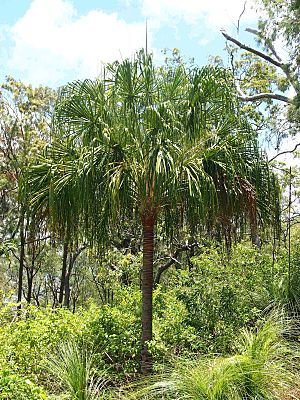Livistona decora facts for kids
Quick facts for kids Livistona decora |
|
|---|---|
 |
|
| Scientific classification | |
| Genus: |
Livistona
|
| Species: |
decora
|
| Synonyms | |
|
|
The Livistona decora is a type of palm tree. It is also known as the Australian Fan Palm or Weeping Cabbage Palm. This palm is special because it grows naturally only in Queensland, Australia. You can find it in woodlands where the trees have tough, leathery leaves.
This palm is found in a narrow strip along the coast. It grows from Magnetic Island near Townsville down to Rainbow Beach. People around the world now grow Livistona decora as a beautiful plant in gardens and parks, especially in dry areas.
Contents
What it Looks Like
The Livistona decora is a tall and graceful palm. It can grow up to 18 meters (about 59 feet) high. That's like a six-story building!
Leaves and Trunk
Its leaves are shaped like a fan, but they also have a strong central rib. This makes them look a bit like a feather and a fan combined. The stalks of the leaves can be very long, up to 300 centimeters (about 10 feet). These stalks have sharp, black spines along their edges, so be careful!
Flowers and Fruits
This palm produces long flower stalks, called inflorescences. They can be up to 350 centimeters (about 11.5 feet) long. After the flowers, the palm grows shiny black fruits. Each fruit is small, about 20 millimeters (less than an inch) across.
Where it Grows
Livistona decora is native to Queensland, Australia. It prefers to grow in woodlands that have a lot of sun and well-drained soil. It is very good at handling dry conditions once it is established. This makes it a popular choice for landscaping in places with hot, dry climates.
Uses of the Palm
This palm is mostly grown for its beauty. Its tall, slender trunk and elegant, drooping leaves make it a great decorative plant. It is often planted in parks, along streets, and in large gardens.
Some parts of the palm might have been used as Bushfood by Indigenous Australians. However, it is mainly known today as an ornamental plant.
See also
 In Spanish: Livistona decora para niños
In Spanish: Livistona decora para niños

